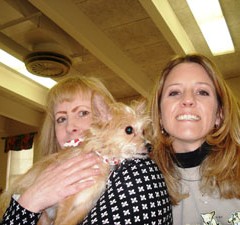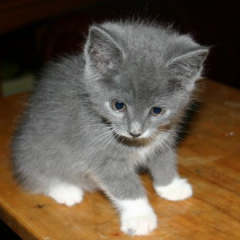A Story of Hope
When King William county animal control rescued Hope in mid-February several years ago, they had little hope that she would survive. She weighed only 31 pounds and was anemic, malnourished, and very dehydrated. In fact, the poor emaciated creature so weak she was unable to stand. Because some Virginia counties have limited resources and few links to rescue groups and humane societies to help them with the animals. Routinely, Hanover Humane’s volunteers visit local shelters and pounds to find adoptable animals so they can be rehabilitated and find forever homes. It was on one of these visits that Hanover Humane found the dog named “Hope.” After being hospitalized for a week at the King William Veterinary Clinic, Hope gained 7 pounds and, though unsteady on her feet, was able to finally stand on her own. She received antibiotics, IV fluids, vaccinations, a lot of puppy food and many prayers. In addition to being near starvation, Hope had several other health concerns which made her recovery questionable: severe anemia and a severe case of heartworms. Not to be daunted, her foster mom and dad provided Hope with much needed TLC; they doted on her! Gradually, Hope began to gain weight and feel better; her fur began to grow back. To our surprise, Hope was a beautiful chocolate lab! Hope continued to do well, but, due to the severity of the heartworms, the vet didn’t feel that Hope could withstand heartworm treatment. Her only option was to be placed on monthly preventative and monitored for whatever time she had left. On April 3, Hope went to the veterinarian for a check-up. At 49 pounds, her white and red blood cell counts are normal and she is no longer anemic. Hope has a good disposition and Hanover Humane wanted to find her a home; however, her overall health was still not assured due to advanced heartworm disease and its consequences. Because Hope had been through so much and had survived, she had a place in the hearts of each of Hanover Humane’s adoption volunteers. One volunteer in particular, Miss Beverly, was deeply attached to Hope. After several sleepovers to see how Hope would react to a new environment, Miss Beverly decided to adopt Hope. Hope and Miss Beverly are very happy! While we see Miss Beverly several times a week, occasionally Hope will decide to tag along so we can play with her and see how she’s doing. We’re eternally grateful to Miss Beverly for giving Hope such a wonderful home, and, if Hope could speak, I’m sure she’d tell Miss Beverly that she loves her very much. In honor of Hope Hanover Humane Society has started a new special...
Mr. Chip helps out at Pearson’s Corner
Recently, Pearson’s Corner Elementary School embarked on a school-wide reading campaign on January 11, 2010. To kick-off the event, the school organized several assemblies where the children met “Chip”, a former Hanover Humane Society pup. The children learned about Chip, his mom, and his brother and sisters who all were in Hanover Humane’s foster program. The children asked “Chip” questions, and then he walked around to meet all of them in the assembly hall. As a show of thanks, the children gifted “Chip” with some goodies that he could share with Hanover Humane’s foster animals. “Chip” enjoys going out in public to meet people and share information about Hanover Humane’s Adoption, Education, and Prevention Programs. He’s had a number of “speaking” engagements recently with several more planned over the next months. If you’d like to meet “Chip” and have him come to your special event, birthday party, etc. please email him at info@hanoverhumanesociety.org to obtai more...
South Pawcific
This event would not have been possible with our the support of our event sponsors and the many volunteers who graciously gave of their time. We would also like to thank Loving Pets Crematory and Nelsen Family Funeral for their generous donation of a van for the SNIP Program! See more pics...
Did You Know?
According to the Cornell Feline Health Center, the conventional formula for converting a cat’s age to “people years” is not accurate. Contrary to popular wisdom, a year in the life of a feline is not the same as seven years for their human caretaker. Instead, a one-year-old cat is equivalent to a 16-year-old human adolescent. A two-year-old cat is equivalent to a 21-year-old person. After that, each cat year is equivalent to four human years. Therefore, a 5-year-old cat would be 33 years old in people years. A 10-year-old cat would be 53, and a 15-year-old kitty would be 73 in human...
Litter Box: Friend or Foe?
Cats are well known for being fairly easy to train to use a litter box. It is a natural thing for cats, but what do you do when your cat suddenly stops using the box and begins using your floor or furniture as an alternative? The first thing to look for are changes that could be stressing your cat. There is always a reason why a cat that was trained to use the box suddenly stops. Maybe you have brought a new animal into the home, maybe you have relatives staying over, maybe you have changed the brand of litter, or maybe the box was just dirty when the cat went to use it. Litter boxes should be cleaned at least once a day. A good rule of thumb is that you should have one litter box per cat in your household. If you have multiple cats it might also be that you need litter boxes in multiple places. If you have a multi-story house, make sure that you have a litter box on each floor. If your cat has stopped using the box, discard all of the litter daily and be sure to clean the box thoroughly with water before adding new litter. A little lemon juice or vinegar can be used to wipe the empty box down. Never use any ammonia based cleaners as this makes the box smell “dirty” to the cat and they will often refuse to use it. Some kitties are also sensitive to specific litters. Clay-based litters are usually preferred by our most “picky litter” cats, but if there was a litter change that coincided with the refusal to go to the box, go back to your previous litter. You should always make litter changes very slowly for cats, as some of them can be very sensitive about it. Any areas in the home that the cat has used instead of their box need to be cleaned thoroughly with an enzyme cleaner to eliminate the temptation of using the spot again. You will also need to confine your cat in a room with its litter box for “reprogramming”. For some cats that merely takes keeping them in the room with the box for a day or so; others can take weeks. As you gradually give your kitty more freedom, make sure that you keep a close eye on him or her. We don’t want any new accidents during the retraining period. There can also be medical reasons why kitties suddenly stop using their boxes, so if there have been no changes in the cat’s routine and you have tried everything else, make sure...
How to Prevent Heatstroke
Sun + humidity = heatstroke Everyone knows that the inside of a car on a hot summer’s day can be lethal. But Fido needs you to know more than that to keep him safe in the deadly sun. Days above 90 degrees, especially with high humidity, are inherently dangerous for your pet. Humidity interferes with an animal’s ability to rid themselves of excess body heat. When we overheat we sweat, and when the sweat dries it takes excess heat with it. Our four-legged friends only perspire around their paws, which is not enough to cool the body. To rid themselves of any excess heat, animals pant. Air moves through the nasal passages, which picks up excess heat from the body. As it is expelled through the mouth, extra heat leaves with it. Although this is a very efficient way to control body heat, it is severely limited in areas of high humidity or when the animal is in close quarters. The shape of an animal’s nasal passages can contribute to an animal’s tendency to overheat. Brachiocephalic (pug-nosed) dogs are more prone to heatstroke because it’s more difficult for them to circulate sufficient air for cooling. Over-weight dogs are also more prone to over-heating because their extra layers of fat act as insulation, which traps heat in their bodies and restricts their breathing capabilities. Age can also be a factor. Very young animals may not have a fully developed temperature regulating system, and older pets’ organ systems may not be functioning at 100 percent, leaving them prone to heat-related damage. Cracking the windows doesn’t cut it Your car can become a death trap even on a mild sunny day when temperatures can rise insidiously to well above 120 degrees. Never, ever leave your pet inside the car. If Fido can’t come with you when you get out of the car, leave him at home. Their lives are in your hands Heatstroke is a medical emergency. If you suspect your pet has heatstroke (see “Signs of Heatstroke” in box), you must act quickly and calmly. Have someone call a veterinarian immediately. In the meantime, lower the animal’s body temperature by applying towels soaked in cool water to the hairless areas of the body. Often the pet will respond after only a few minutes of cooling, only to falter again with his temperature soaring back up or falling to well below what is normal. With this in mind, remember that it is imperative to get the animal to a veterinarian immediately. Once your pet is in the veterinarian’s care, treatment may include further cooling techniques, intravenous fluid therapy to counter shock, or...













